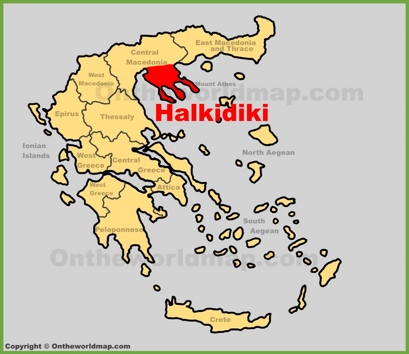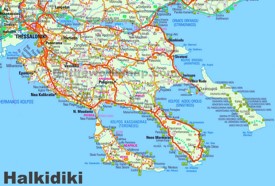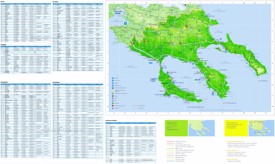Halkidiki Maps
Online Map of Halkidiki
About Halkidiki
Halkidiki is a peninsula located in Central Macedonia in northern Greece. The peninsula extends into the Aegean Sea and is characterized by its distinctive three-pronged shape, consisting of three smaller peninsulas: Kassandra, Sithonia, and Mount Athos (Agion Oros). The total area of Halkidiki covers approximately 2,918 square kilometers.
The main city and administrative center of the peninsula is Polygyros, situated in the interior of the peninsula with a population of around 10,000 residents. Other significant towns include Nea Moudania, a major commercial hub and transportation center, and Arnea, a traditional mountain village known for its textile industry.
The region is renowned for its extensive coastline stretching over 500 kilometers, featuring numerous beaches and resort areas. Popular tourist destinations include Kallithea, Afytos, and Pefkohori on the Kassandra peninsula, as well as Vourvourou and Sarti on Sithonia. The peninsula attracts millions of visitors annually, primarily during the summer months.
Halkidiki has a rich historical heritage dating back to ancient times. The ancient city of Olynthos, located near modern-day Nea Olynthos, was a significant city-state in classical Greece until its destruction by Philip II of Macedon in 348 BCE. Archaeological excavations at the site have revealed well-preserved examples of ancient Greek urban planning. The Petralona Cave, discovered in 1959, contains important paleontological findings, including a human skull dating back approximately 700,000 years.
The peninsula's economy relies heavily on tourism, agriculture, and fishing. Olive cultivation, beekeeping, and wine production are traditional industries that continue to thrive. The region produces honey that is exported internationally, particularly the pine honey harvested from the forests of Sithonia. Agriculture in the fertile plains includes cultivation of olives, cereals, and various fruits.
The climate is typically Mediterranean, with hot, dry summers and mild, wet winters. The interior regions experience more continental climate characteristics, with cooler temperatures and occasional snowfall during winter months. The peninsula's varied landscape includes sandy beaches, rocky coastlines, dense pine forests, and mountainous terrain reaching elevations of up to 1,165 meters at Mount Holomontas.
The Facts:Region: Central Macedonia.
Cities and towns: Nea Moudania, Nea Kallikrateia, Polygyros, Yerakini, Psakoudia, Kallithea, Chanioti, Pefkochori, Nikiti, Neos Marmaras, Ouranoupolis, Arnaia.
Area: 1,127 sq mi (2,918 sq km).
Population: ~ 120,000.
Maps of Greece
Cities of Greece
Greek Islands
Peninsulas of Greece




